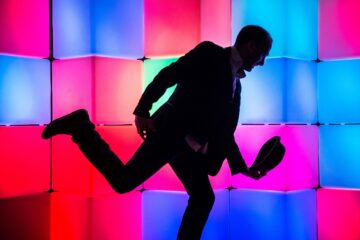
Originally published in the Marina Times San Francisco in December 2023
The Exploratorium is bringing back luminous art in Glow: Discover the art of light. The show returns to Pier 15 through the end of January 2024 bringing with it a range of interactive experiences. Compose music with light, touch quantum physics and see yourself in mechanical mirrors in this groundbreaking installation.
Compose and create with large-scale sound and light
Sound Sculpture by Masary Studios is an interactive sound and light instrument created for spontaneous musical improvisation. 25 location- aware blocks comprise a massive wireless midi controller, with each cube representing a note in spatial dimension and time. The interaction and placement of the cubes creates sound composition. The light installation Flux by Collectif Scale is a kinetic project in which multiple lines of dynamic light twist and turn to form a living robotic sculpture. A headset allows the viewer to immerse in original compositions synchronized with the sculpture’s movements.
Quantum Physics and Experimental LED dungeon crawlers
Robin Baumgartner’s Quantum Jungle simulates a mathematically accurate model of quantum particle movement using Schrödinger’s Equation when attendees move any of its touch sensitive metal springs and thousands of LED’s. The bursts of light demonstrate the movement of a quantum particle including movements like wave-particle duality, interference and quantum waveform collapse. Line Wobbler is a one-dimensional dungeon crawler game. The wobble controller is made from an upside down shoe tree connected to an LED strip display. Hand-eye coordination is key to successfully battling enemies, lava and force fields. Can you complete all nine levels?
Unveil hidden crystals
Crystal Paintings by Maria Constanza Ferreira is a prismatic phenomenon where polarized light emanating from a lightbox passes through crystals. The artist grows synthetic crystals on glass slides then places them in aluminum lightboxes. The polarizing filter placed behind the glass slide creates a prismatic phenomenon when the lens is rotated and the crystal designs appear to dance. A selection of Ferreira’s short films will be in the Osher Gallery 1 Microcinema.
Mechanical mirrors
Daniel Rozin’s Self-Centered and Self-Isolating Mirrors have been in the Exploratorium for years, but Glow will feature three more pieces from Rozin’s Mechanical Mirror Series. RGB Lights Mirror uses rotational motion to produce images using the additive color model – red, green and blue light. Aluminum knobs are programmed to rotate toward or away from colored light, each knob operating as a pixel, and its subsequent rotation influences its reflected color. This creates a 3D illusion of highly saturated images. CMY Shadows Mirror is a circular wall of lights producing full-color reflections. The subtractive color model- cyan, magenta and yellow – is used to filter out light that would otherwise be reflected as white. In the interactive mode, the viewer is reflected, and a different mode displays previously programmed animations. This exhibit includes the debut of Rozin’s One Candle Mirror. Using a single candle as its light source, the light is manipulated through 278 motor-mounted 3D printed lenses which move independently. Like CMY Shadows, One Candle Mirror has two modes: one where the viewer is reflected and a mode when programmed animation takes over.
Meditate on color in motion
Chaco Kato’s Color Study is an evolving installation. A seemingly weightless artwork made of thousands of pieces of string is the backdrop for constantly changing colors and geometric patterns projected onto the object. The colors correspond to the frequency of sound waves in musical compositions that influence the visual in unexpected ways.
Find your bliss beneath a vast glowing moon
Luke Gerram’s Museum of the Moon returns as a Glow favorite. A spherical model of the Moon with a diameter of 7 meters, it shows every cliff and crater of the Moon using 120 dpi imagery captured by NASA at an approximate scale of 1:700,000.
The public can get a preview of light interaction at the Exploratorium’s website where, on the Make your Own Light Art page, anyone may interact via touch with the adaptation of Smoke Simulator, originally created by Rachel Bhadra, Jonathan Ngan and Kenneth Tsai at UC Berkeley. An amber flame appears as a result of touch and the flame-like shapes swirl into existence under the user’s direction. As a dazzling holiday show for friends and family, Glow: Discover the art of light illuminates the power of light to connect, reveal and inspire.